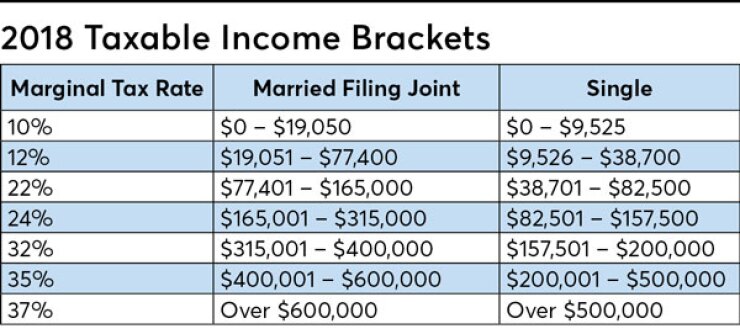Here’s what will happen next year at tax time. Your client’s accountant will tell your client about all the tax planning that could have been done last year. But by then, it will already be too late.
That’s because, unfortunately, many tax preparers are history teachers. They tell you what already happened. Nobody wants to hear woulda, coulda, shoulda.
How about changing this annual annoying scenario? Instead, be a proactive financial planner right now. It’s more essential than ever before. With all the new tax law changes, every advisor should alert clients about what can be done now to help them avoid taxpayers’ remorse next year.
Consider these five ideas to stay ahead of the game.
1. Roth conversions: The Tax Cuts and Jobs Act eliminated the ability to reverse or recharacterize a Roth conversion. The new rule applies to conversions done in 2018 and later years.
-
There are only two ways to transfer IRA assets tax free in a divorce proceeding.
May 15 -
The itemized deduction for investment fees may have been eliminated, but clients still need guidance on paying IRA expenses. Here's what to tell them.
May 4 -
Sometimes the strategy can eliminate a domino effect of other expensive tax problems down the road, Ed Slott writes.
March 20
In past years, if a Roth IRA conversion resulted in an unexpectedly high income-tax bill, or if the client simply changed his or her mind, the conversion could be reversed by recharacterizing the Roth IRA funds back to a traditional IRA. However, starting in 2018, this option no longer exists.
But there’s still a short-term recharacterization planning opportunity, if you act now. The IRS has said that 2017 Roth conversions can still be undone up to October 15, 2018. However, each client needs to consider this option individually.
All else being equal, a tax arbitrage strategy can work for your clients, where you reverse last year’s Roth conversion and remove the tax bill at last year’s higher rates, and then replace it with a Roth conversion this year at lower tax rates. That’s OK if income is roughly the same each year.
But you’ll need to look further, for example, to see what 2017’s tax bracket actually was (most clients will have a good handle on those numbers by now), and how it will compare to this year’s lower and more expanded tax brackets. You’ll also have to see how well the 2017 converted funds performed.
For instance, if they are up substantially, those are tax-free gains and in that case, the conversion most likely should not be undone. Why move tax-free gains back to a taxable IRA? Also, compare the 2017 tax return with a projected 2018 tax return to see if there are any spikes or income aberrations to plan around.
For example, if 2017 included a large business loss that would have made last year’s Roth conversion less costly, then that conversion is worth keeping. Or on the other hand, maybe 2018 will have large deductions or losses that would make a 2018 conversion more tax efficient, as opposed to the 2017 conversion.
This reverse-and-replace strategy is a one-time opportunity that ends on October 15, 2018. After that, any new Roth conversion is permanent. It cannot be undone and that tax will be owed, so advisors will need to be extra careful to plan out the projected tax bill on any 2018 Roth conversions they’re considering. A conversation now — not next year — with the client’s tax preparer would be especially helpful.
Yes, Roth conversions are permanent, but that certainly doesn’t mean they should be avoided. The long-term tax-free benefits are too good to pass up. It just means that clients will need more planning advice when considering Roth conversions in the future.
Here are three more tax-planning ideas to better project the tax bill for converting an IRA to a Roth IRA:
- Make the conversion late in the year when tax results for the full year can be more accurately estimated, especially given the current market volatility.
- But there’s an exception to that advice. If the market takes a big dip earlier in the year, consider converting while stock prices are low.
- Your client may also want to consider making only a partial conversion to minimize the tax costs. A series of annual partial conversions may convert even a large IRA without pushing income up into higher tax brackets. Have the new tax brackets available to better project next year’s tax bill.

2. Plan a qualified charitable distribution: This is one of those strategies that the client will only hear about next year when it’s too late to take advantage of a QCD for this year. As a result of the new tax law, more clients will be taking a standard deduction and their charitable gifts will no longer be deductible. But the QCD gives the client a double advantage. They can take the standard deduction and effectively add a charitable deduction on top of that, by having those gifts being excluded from income.
Instead of the old way of writing a check and taking a tax deduction, all clients who qualify should make their gifts via QCDs, where the gift is made as a direct transfer from an IRA to the charity.
The only negative is that the provision isn’t available to more taxpayers. It only applies to pre-tax funds in IRAs, not company plans, and clients must be at least age 70½ at the time of the QCD to qualify. A QCD may be as large as $100,000 per person (not per IRA) and can be used to satisfy a client's RMD requirements. QCD rules prohibit using donor-advised funds or private foundations.
Because a QCD is not included in income as a distribution, tax-wise, this is better than taking a taxable IRA distribution and trying to offset it with a charitable contribution deduction.
The QCD does not increase adjusted gross income as a taxable IRA distribution does. Higher AGI can be costly in several ways, for instance by increasing income tax on Social Security benefits and increasing Medicare premiums. When a client is nearing age 70½, it may make sense to delay making charitable contributions until the client becomes eligible to make use of QCDs.
The tax savings here can be significant. For example, say a client will be in the new 24% tax bracket for 2018 and makes a $10,000 gift using the QCD. If the RMD happens also to be $10,000, then none of that RMD is included in income. If the client is taking the standard deduction where no charitable contributions are deductible, this $10,000 QCD provides an effective tax deduction and will reduce the 2018 tax bill by $2,400 ($10,000 lower taxable income x 24% tax rate = $2,400 tax savings) compared to giving the old way — without the QCD. That’s a big tax savings on the same gift. The savings are highest when the client takes the standard deduction, but due to the lower AGI limits, there are still tax savings even for clients who are itemizing their deductions.
Talk with clients about this now.
3. IRA fees no longer deductible: Advisor investment fees are no longer deductible as an itemized deduction. Let clients know this now and provide some alternatives, rather than have their CPA tell them next year at tax time. The bottom-line strategy here is to pay IRA fees from the IRA. This will provide an effective tax deduction since the fees are being paid from pre-tax funds.
But never do this from the Roth IRA since those are after-tax funds. In that case, pay the Roth fees from other taxable funds, even if there is no tax deduction available. Roth fees cannot be paid from the traditional IRA. For more detail on these planning strategies, please see
4. Anticipate taxes from the pro-rata rule: The IRS aggregates all traditional IRAs, including SEP and SIMPLE IRAs, as one when determining the tax due on distributions. This can result in a surprise tax bill if clients are unprepared, so review this issue with clients now, before doing any Roth conversions or taking other IRA distributions.
Example: To make a back-door Roth IRA contribution, Jack makes a $5,000 nondeductible contribution to a new traditional IRA and promptly converts it to a Roth IRA. All the funds in this traditional IRA are post-tax, so he expects no taxable income to result. This would be true if Jack owned only that traditional IRA.
However, Jack also owns another IRA holding $120,000, consisting entirely of pre-tax contributions and earnings. The IRS will aggregate the two IRAs and treat them as one with a balance of $125,000. Of that, $5,000, or 4%, consists of after-tax funds.
Thus, Jack’s $5,000 Roth IRA conversion will produce $4,800 of taxable income. The converted funds are 96% taxable and 4% tax free, as will be any distribution from either IRA.
Before making any Roth IRA conversion or IRA distribution, check the impact of the pro-rata rule to avoid giving the client an incorrect estimate of the tax bill. This mistake cannot be undone since Roth recharacterizations are no longer available.
5. Plan for RMDs: Check clients' RMD obligations and be sure they are met. Remember there’s a whopping 50% penalty for missing one!
- If a client has multiple traditional IRAs, under the aggregation rules, the year's entire RMD can be taken from any one of those accounts. This can be a way to adjust the amounts left to different beneficiaries or, if the IRAs invest in different kinds of assets, to liquidate particular assets first.
- For a client who reaches age 70½ during 2018, the first RMD must be taken by April 1, 2019. For others, RMDs must be taken by year-end. If 2018 income will be considerably lower than 2019, it might pay to look at taking all or part of the first RMD in 2018.
- Remember, clients who inherit Roth IRAs as non-spouse beneficiaries are also subject to RMDs.

Now is the time to help your clients plan their 2018 IRA–related tax moves. Do not wait until next year when little can be done to change the outcome.
End the woulda, coulda, shoulda syndrome.
To find more valuable tax insights from Ed Slott,
This story appears in Financial Planning’s





